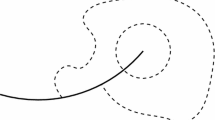Abstract
The locus of points around a crack tip where the strain energy density is set equal to a critical value reveals interesting features. It is seen that, for certain cases, two points on this locus remain invariant with respect to the phase of the applied loads. The existence of these invariant points is examined for different configurations - a crack in a homogeneous isotropic medium, an interface crack and an inclined interface crack. This analysis is extended to the two components of strain energy density – volumetric (VSED) and distortional (DSED).
Similar content being viewed by others
References
Bogy, D.B. (1971). On the plane elastostatic problem of a loaded crack terminating at a material interface. Transactions of ASME, Journal of Applied Mechanics 38, 911–918.
Boniface, V. and Simha, K.R.Y. (1991). A plastic zone model of mixed mode fracture. International Journal of Fracture 48, R9–R12.
Boniface, V. and Simha, K.R.Y. (1996). Plastic energy dissipation in mixed mode fracture. International Journal of Fracture 73(1), R6–R9.
Chen, D.-H. (1994). A crack normal to and terminating at a bimaterial interface. Engineering Fracture Mechanics 49(4), 517–532.
Chen, J.-T. and Wang, W.-C. (1995). Theoretical and experimental analysis of an arbitrarily inclined semi-infinite crack terminated at the bimaterial interface. Journal of Strain Analysis 30(2), 117–128.
Erdogan, F. and Sih, G.C. (1963). On the crack extension in plates under plane loading and transverse shear. Transactions of ASME, Journal of Basic Engineering 85, 519–527.
Glinka, G. (1985). Energy density approach to calculation of inelastic strain-stress near notches and cracks. Engineering Fracture Mechanics 22(1), 485–508.
Hills, D.A. and Barber, J.R. (1993). Interface cracks. International Journal of Mechanical Science 35(1), 27–37.
Hutchinson, J.W., Mear, M. and Rice, J.R. (1987). Crack paralleling an interface between dissimilar materials. Transactions of ASME, Journal of Applied Mechanics 54, 828–832.
Moftakhar, A., Buczynski, A. and Glinka, G. (1995). Calculation of elasto-plastic strains and stresses in notches under multiaxial loading. International Journal of Fracture 70, 357–373.
Molski, K. and Glinka, G. (1981). A method of elastic-plastic stress and strain calculation at a notch root. Materials Science and Engineering 50, 93–100.
Neuber, H. (1961). Theory of stress concentration near shear-strained prismatical bodies with arbitrary nonlinear stress-strain law. Transactions of the ASME, Journal of Applied Mechanics 28, 544–550.
Rice, J.R. (1988). Elastic fracture mechanics concepts for interfacial cracks. Transactions of ASME, Journal of Applied Mechanics 55, 98–103.
Romeo, A. and Ballarini, R. (1994). The influence of elastic mismatch on the size of the plastic zone of a crack terminating at a brittle-ductile interface. International Journal of Fracture 65, 183–196.
Sharpe, W.N., Jr., Yang, C.H. and Tregoning, R.L. (1992). An evaluation of the Neuber and Glinka relations for monotonic loading. Transactions of the ASME, Journal of Applied Mechanics 59, S50–S56.
Sih, G.C. (1974). Strain energy density factor applied to mixed mode crack problems. International Journal of Fracture 10, 305–322.
Shih, C.F. (1974). Small-scale yielding analysis of mixed-mode plane-strain crack problems. Fracture Analysis, ASTM STP 560, 187–210.
Shih, C.F. and Asaro, R.J. (1988). Elastic-plastic analysis of cracks on bimaterial interfaces: Part I — Small-scale yielding. Transactions of ASME, Journal of Applied Mechanics 55, 299–316.
Shih, C.F. and Asaro, R.J. (1989). Elastic-plastic analysis of cracks on bimaterial interfaces: Part II — Structure of small-scale yielding fields. Transactions of ASME, Journal of Applied Mechanics 56, 763–779.
Sih, G.C. and Rice, J.R. (1964). The bending of plates of dissimilar materials with cracks. Transactions of ASME, Journal of Applied Mechanics 31, 477–482.
Singh, M.N.K., Glinka, G. and Dubey, R.N. (1996). Elastic-plastic stress-strain calculation in notched bodies subjected to non-proportional loading. International Journal of Fracture 76, 39–60.
Symington, M., Shih, C.F. and Otriz, M. (1988). Tables of plane-strain mixed-mode plastic crack-tip fields, Brown University Report, MRG/DMR-8714665/1.
Theocaris, P.S. and Andrianopoulos, N.P. (1982). The Mises elastic-plastic boundary as the core region in fracture criteria. Engineering Fracture Mechanics 16(3), 425–432.
Wang, W.-C. and Chen, J.-T. (1993). Theoretical and experimental re-examination of a crack perpendicular to and terminating at the bimaterial interface. Journal of Strain Analysis 28(1), 53–61.
Wang, W.-C. and Chen, J.-T. (1994). Singularities of an arbitrarily inclined semi-infinite crack meeting a bimaterial interface. Engineering Fracture Mechanics 49(5), 671–680.
Williams, M.L. (1959). The stresses around a fault or crack in dissimilar media. Bulletin of the Seismological Society of America 49(2), 199–204.
Yishu, Z. (1991). Behaviour and criterion of quasi-brittle fracture of metals. Engineering Fracture Mechanics 39(4), 683–686.
Yong-li, W. (1992). Crack-tip stress singularities in bimaterial with an inclined interface. International Journal of Fracture 54, R65–R72.
Zak, A.R. and Williams, M.L. (1963). Crack-point stress singularities at a bimaterial interface. Transactions of ASME, Journal of Applied Mechanics 30, 142–143.
Zywicz, E and Parks, D.M. (1989) Elastic yield zone around an interfacial crack tip. Transactions of ASME, Journal of Applied Mechanics 56, 577–584.
Author information
Authors and Affiliations
Rights and permissions
About this article
Cite this article
Boniface, V., Simha, K. Invariant Points on Energy Contours Around a Crack Tip Under Mixed Mode Loading. International Journal of Fracture 86, 301–325 (1997). https://doi.org/10.1023/A:1007479819694
Issue Date:
DOI: https://doi.org/10.1023/A:1007479819694




